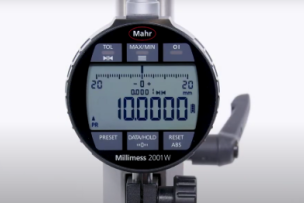Brinell Hardness
Brinell hardness testing is commonly used for very large, porous testing of less hard metals, such as castings. Benchtop systems available today can handle the most popular Brinell hardness applications, and incorporate the latest innovative closed-loop technology. A test load is applied via a closed-loop control unit with a load cell to apply weight loads up to 3,000kg, a DC motor and an electronic measurement and control unit. The result is highly accurate Brinell hardness measurements at all test loads up to 0.5%. A common load overshoot or undershoot, also known as traditional dead weight or open-loop, system is eliminated. The absence of mechanical weights not only eliminates friction problems but also makes the equipment less sensitive to misalignments caused by vibrations. The systems are ideal for laboratories, workshops, tool rooms and inspection labs.
Software-driven digital optical systems offer advantages over manual microscopes that are supplied with several hardness testing machines. Connected to a PC, laptop or tablet, the operator can push a single button to take automatic and instant measurements. All graphics can be saved, along with test results, in either Word or Excel formats.
Vickers/Knoop Hardness
Micro Vickers/Knoop Hardness Testers are cost-effective options in Vickers hardness applications, that are ideal for those who do not perform high-volume testing each day. Testing is done on extremely thin/small workpieces, and often used for checking the hardness of layers, or platings and coatings on small parts in a laboratory environment. A high level of preparation is needed for such testing, including but not limited to, a high degree of polishing.
There are three types of turret control including a basic manual turret for changing from optics to indentation and back to optics for measuring. A second type incorporates an automatic turret, giving operators greater freedom to change the turret position by a button on the tester keypad. The most popular Vickers/Knoop Hardness Testers have a turret control option using software to control the entire test with a one-click process using calibrated auto edge detection. Precision video and measurement software also allows for clicking of the indent edges in software, then deriving a hardness reading on screen.
Designed for the accurate hardness testing of small precision parts, thin materials, case-hardened layers and all sorts of steel components, Macro Vickers Hardness Testers utilize larger weight loads of up to 50kg. This type of test bridges the gap between the superficial Rockwell and micro Vickers machines. These systems have a manual turret.
Shore Testers (Durometers)
Shore Portable Hardness Testers are targeted for testing materials such as rubber, soft plastics and leather, and versions are also available for the testing of hard plastics such as bowling balls and hard hats. Electronic Durometers for measuring Shore A and Shore D values are designed to fit comfortably and firmly in a user's hand. A large LED display and simple three-button control make this device easy to use.
Portable Hardness Testers
There are two popular digital methods of portable hardness testing. The first is "Dynamic Impact", based on the Leeb principle of hardness, developed by DietMar Leeb in the 1970s. A spring-loaded impact body is thrust to the test surface, affecting rebound. Initial thrust and rebound speed is measured in a non-contact mode, and is calculated as a Leeb hardness value and then automatically converted to Rockwell C, B, Brinell, Vickers and Shore Values. Also, the portable benefit means the tester can be brought to the workpiece, which is especially useful when testing large and/or cumbersome parts. This method has resulted in efficient, fast and accurate portable hardness testing results.
However, when a mark or indentation on the workpiece must be avoided, ultrasonic testing is a great solution. Advanced Non-Destructive Portable Hardness Testers utilize ultrasonics with Ultrasonic Contact Impedance (UCI) technology, enabling a portable hardness tester to test special surfaces on small and thin workpieces without marking the surface. These units can test metals as thin as 2mm throughout all scales, hard or soft. UCI technology is available on both manual and motorized systems. The motorized probe systems are used for very thin testing of coatings and platings, or surfaces with a very high polish finish.
UCI is based on a 136 degree diamond at the end of a vibrating rod being depressed into the test surface at a fixed load. The difference in Ultrasonic vibration frequency is then calculated into a hardness value. The UCI test procedure is slower than the Dynamic Impact style; however, the UCI method has the advantages of being non-destructive and able to test thin and small work parts.
Previously, destructive indentations made on such sample pieces meant the garbage heap for those tested. Using Ultrasonics, this is no longer the outcome. These systems have an open architecture and can be calibrated to read any metal, in any hardness scale, with reference samples to perform initial calibration. Ultrasonic portable hardness testing is ideal for applications such as bearings, pistons and valves, among many others. Key industries for this type of testing include aerospace, automotive and medical parts as well as knife blade manufacturing, to name just a few.










Talk to Us!
We were considering to buy a hardness tester for more accurate measurements in aluminum extrusions (profiles). The profiles a typically hollow and have walls of 1/16" to 1/4" thickness, or sometimes they are solid. We currently use the handheld Webster hardness meters, in the range from 4 to 20 Webster hardness, but sometimes we need more accuracy and repeatability of the measurements. What kind of hardness tester would you recommend? Thanks,
40We have 2 bench top units in stock that can do that. MSC# 92494990 is a dial analog tester and MSC# 92944982 is the same tester with a electronic gage in it. Both will read in Rockwell e scale for the aluminum. The E scale can be converted to Webster in the link below.
https://images-na.ssl-images-amazon.com/images/I/81gspE-9J1L.pdf
Also, i would suggest the 1/8" ball penetrator to get to the E scale MSC# 83982983
Fell free to contact me with questions or our customer care team @ 800-645-7270 If you would like Price and Availability.
30Leave a reply
Your email address will not be published. Required fields are marked *